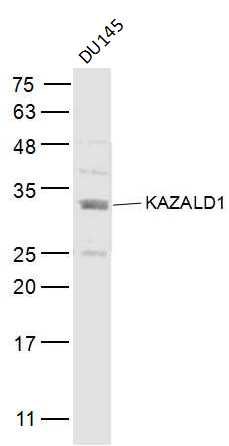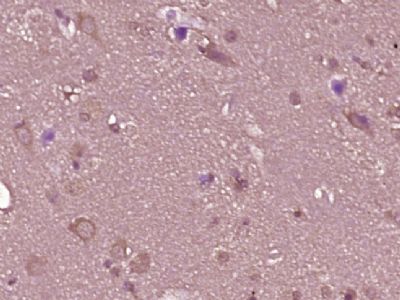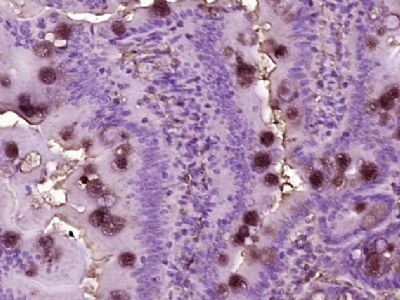KAZALD1 Polyclonal Antibody
Purified Rabbit Polyclonal Antibody (Pab)
- SPECIFICATION
- CITATIONS
- PROTOCOLS
- BACKGROUND

Application
| WB, IHC-P, IHC-F, IF, ICC, E |
|---|---|
| Primary Accession | Q96I82 |
| Reactivity | Rat, Pig, Dog, Bovine |
| Host | Rabbit |
| Clonality | Polyclonal |
| Calculated MW | 30 KDa |
| Physical State | Liquid |
| Immunogen | KLH conjugated synthetic peptide derived from human KAZALD1 |
| Epitope Specificity | 71-170/304 |
| Isotype | IgG |
| Purity | affinity purified by Protein A |
| Buffer | 0.01M TBS (pH7.4) with 1% BSA, 0.02% Proclin300 and 50% Glycerol. |
| SUBCELLULAR LOCATION | Secreted > extracellular space > extracellular matrix. |
| SIMILARITY | Contains 1 Ig-like C2-type (immunoglobulin-like) domain. Contains 1 IGFBP N-terminal domain. Contains 1 Kazal-like domain. |
| Important Note | This product as supplied is intended for research use only, not for use in human, therapeutic or diagnostic applications. |
| Background Descriptions | BONO1, also known as KAZALD1 (kazal-type serine protease inhibitor domain-containing protein 1), IGFBP-rP10, FKSG28 or FKSG40, is a 304 amino acid secreted extracellular matrix protein that promotes matrix assembly. BONO1 is expressed in developing bones and odontoblasts in teeth, where it plays a role in osteoblast proliferation during bone formation and regeneration. BONO1 is also expressed at high levels in spleen, and is found at lower levels in lung, skin, urinary bladder, brain, tongue, kidney and large intestine. Existing as two alternatively spliced isoforms, BONO1 contains one Kazal-like domain, an IGFBP N-terminal domain and a single Ig-like C2-type (immunoglobulin-like) domain. The gene encoding BONO1 maps to human chromosome 10, which contains over 800 genes and 135 million nucleotides. Cockayne syndrome, Cockayne syndrome and trisomy 10 are associated with defects in chromosome 10. |
| Gene ID | 81621 |
|---|---|
| Other Names | Kazal-type serine protease inhibitor domain-containing protein 1, KAZALD1 |
| Dilution | WB=1:500-2000,IHC-P=1:100-500,IHC-F=1:100-500,ICC=1:100-500,IF=1:100-500,ELISA=1:5000-10000 |
| Format | 0.01M TBS(pH7.4), 0.09% (W/V) sodium azide and 50% Glyce |
| Storage | Store at -20 ℃ for one year. Avoid repeated freeze/thaw cycles. When reconstituted in sterile pH 7.4 0.01M PBS or diluent of antibody the antibody is stable for at least two weeks at 2-4 ℃. |
| Name | KAZALD1 |
|---|---|
| Function | Involved in the proliferation of osteoblasts during bone formation and bone regeneration. Promotes matrix assembly (By similarity). |
| Cellular Location | Secreted, extracellular space, extracellular matrix |

Thousands of laboratories across the world have published research that depended on the performance of antibodies from Abcepta to advance their research. Check out links to articles that cite our products in major peer-reviewed journals, organized by research category.
info@abcepta.com, and receive a free "I Love Antibodies" mug.
Provided below are standard protocols that you may find useful for product applications.
If you have used an Abcepta product and would like to share how it has performed, please click on the "Submit Review" button and provide the requested information. Our staff will examine and post your review and contact you if needed.
If you have any additional inquiries please email technical services at tech@abcepta.com.













 Foundational characteristics of cancer include proliferation, angiogenesis, migration, evasion of apoptosis, and cellular immortality. Find key markers for these cellular processes and antibodies to detect them.
Foundational characteristics of cancer include proliferation, angiogenesis, migration, evasion of apoptosis, and cellular immortality. Find key markers for these cellular processes and antibodies to detect them. The SUMOplot™ Analysis Program predicts and scores sumoylation sites in your protein. SUMOylation is a post-translational modification involved in various cellular processes, such as nuclear-cytosolic transport, transcriptional regulation, apoptosis, protein stability, response to stress, and progression through the cell cycle.
The SUMOplot™ Analysis Program predicts and scores sumoylation sites in your protein. SUMOylation is a post-translational modification involved in various cellular processes, such as nuclear-cytosolic transport, transcriptional regulation, apoptosis, protein stability, response to stress, and progression through the cell cycle. The Autophagy Receptor Motif Plotter predicts and scores autophagy receptor binding sites in your protein. Identifying proteins connected to this pathway is critical to understanding the role of autophagy in physiological as well as pathological processes such as development, differentiation, neurodegenerative diseases, stress, infection, and cancer.
The Autophagy Receptor Motif Plotter predicts and scores autophagy receptor binding sites in your protein. Identifying proteins connected to this pathway is critical to understanding the role of autophagy in physiological as well as pathological processes such as development, differentiation, neurodegenerative diseases, stress, infection, and cancer.




